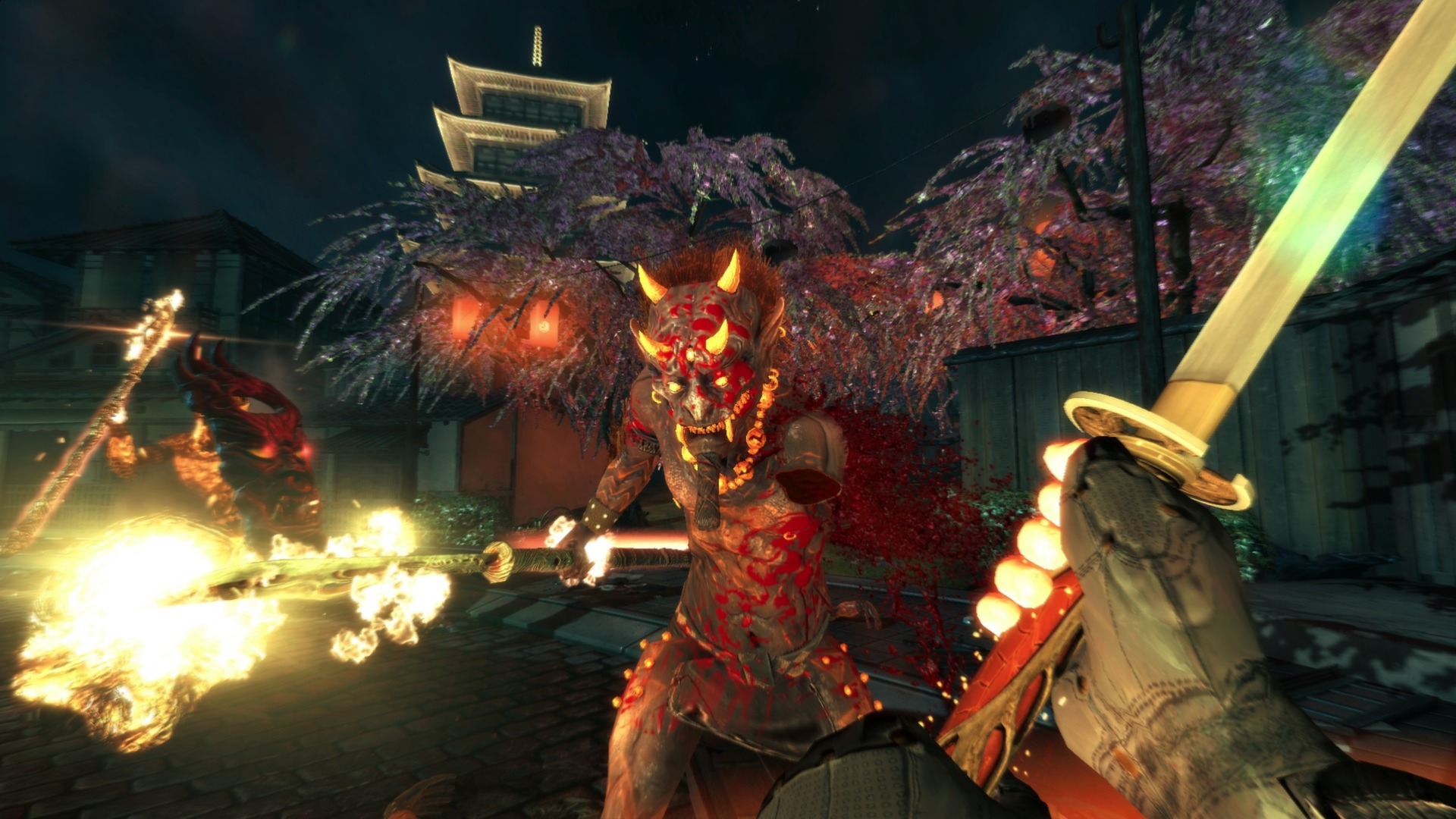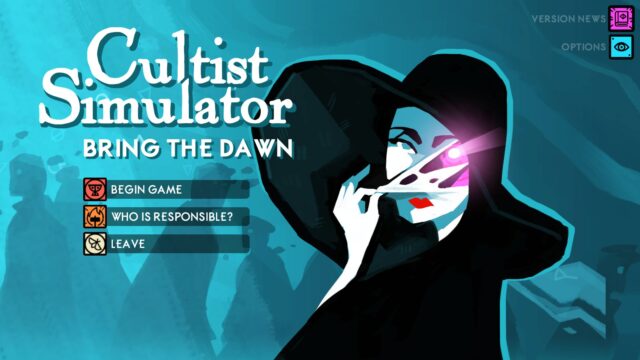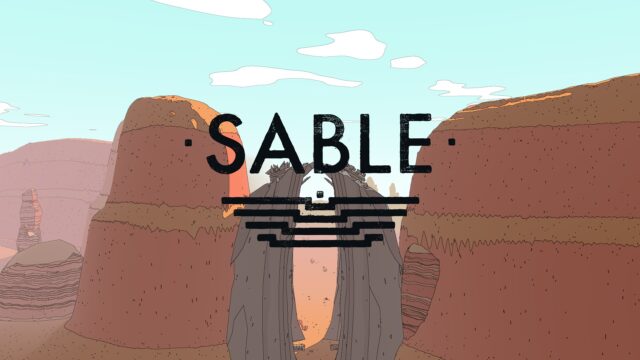Shadow Warrior Review
It was unexpected. I imagined that the return of Lo Wang would be a good idea, but I wasn’t sure about it at all. Two days of insane slaughter convinced me. The main problem with Shadow Warrior is that it is not a reboot of Blood – if Caleb ever returns to our screens, he is unlikely to act in the same characteristic style.
Flesh is divided into parts, shifting along the lines drawn by Lo Wang’s katana. Limbs perform pirouettes in the air, like desperate ballerinas, and entrails scatter in lavish patterns reminiscent of “Black Swan” paintings. Heads fly off shoulders, and the last demon, whose remaining hand begs for mercy, limps and shrivels amidst the remains of its comrades. Shadow Warrior is excessively bloody game – and I find this exaggerated cruelty fantastically captivating.
It’s been a while since I’ve seen so much gore in games, but even in cases where you are up against humans rather than demons, it’s hard to take the local dismemberment seriously. It looks more amusing, like “Evil Dead 2” or “Army of Darkness”. Modern games lack such style, or they deliberately avoid it, and this is the first sign that the reboot understands what made the original great. Also, I think this game continues the traditions of Serious Sam even better than Serious Sam 3, despite not reaching the same scale as the series and despite me liking Serious Sam 3.
Here are a few key aspects of the game that make me reminisce about the 90s.

Killing bad guys is fun!
In the past, we used to destroy computer enemies without any hesitation or remorse. I have already forgotten that feeling because today, even in games about ugly demonic creatures, I have to face moral dilemmas – instead of being rewarded for my active actions, I am presented with their horrible sufferings. When I slice monsters, I don’t want to imagine their grieving wives, extending tearful invitations to their closed-casket funerals.
And sometimes, this happens, and I am happy that the bloody carnage in Shadow Warrior is something that goes without saying and doesn’t require any explanations. The story mostly unfolds in the spirit of stories about a crazy friend (Wang’s friend is a demon who has taken residence in his body) with rare excursions into mythology, which only strive to ruin everything. I don’t care about the backstory and sad memories because they distract me from the deadly dance of sharp steel with armies of darkness.

Caches!
Yes, the second number on the list is lucky (mostly) secret locations. In them, you can usually find one of three upgrade resources, and in the best cases, you can find references to retro. I found a subway station from the original Shadow Warrior when I blew up a wall by shooting a barrel. Not the updated version, but the one with huge pixels and train texture, almost indistinguishable from the wall. The game also hides sprites – dead characters in their old form, ripped straight from the Build engine.
I thought I was always a master at finding hiding places. Nowadays, it’s a forgotten skill in this kind of game, but I’m one of the few who still have it. With a satisfied smirk, collecting hidden gold and karma, I was always angry and amazed at about three out of eleven secrets on each level. This game is definitely worth replaying. Advice? Shoot everything. In the first playthrough – definitely. That’s why you’re given so much ammo.
Secrets also have a negative side, and it’s related to the upgrade system. I don’t like missing out on secrets because it deprives me of new toys, and often you have to go off the main tracks to reach a secret. If there are two corridors, one of them leads to a dead end with a prize, and the other to the next level. There are more fortunate examples, but it’s still disappointing.

Swords!
Here you can return to “killing bad guys is fun”. For this, crossbows and firearms are quite suitable, but swords are a completely different matter. Any weapon will tear enemies apart, but it’s more enjoyable to see the whole process up close. In this regard, a shotgun is also convenient. It is effective at a distance of a meter, as shotguns should behave, but in the game, it is given too late.
Fighting with swords is quite simple. At first, I didn’t like the absence of a block or parry button, but I quickly realized that I was thinking in the wrong direction. Shadow Warrior is like a racing arcade game where you don’t need to hit the brakes. At first, there are two types of attacks here – a powerful swing that cuts enemies in half and standard strikes that form simple combos.
Later, upgrades appear, many of which add new abilities to the katana. I wanted to collect them all and even enjoyed the appearance of the menu for each of the three types. There are either weapon models, or illustrated scrolls, or Wang’s tattooed body. Money is needed for weapons, and one of two types of non-material currency is needed for other menus. Each menu has its own skill tree with interesting passive and active abilities. Active abilities are tied to a combination of two movement buttons and one mouse button. For example, forward, forward, left click is a powerful katana lunge, and double-clicking to the side with a left click is a whirlwind attack that damages in all directions. And it is especially good. There is nothing more enjoyable than running into a crowd of demons, ignoring their attacks, not reaching for your gun, and killing six or seven of them at once.

Explosions!
Do you have a car, motorcycle, barrel, or box of fireworks nearby? This means you need to shoot at them. Sometimes a successful shot can trigger a chain reaction of destruction and chaos, which will blow up an entire street or room and sweep away everything in its path. If something still moves under the rubble, shoot it between the eyes or chop it into pieces – the more diverse killings in each location, the more karma bonus you get. Yes, that’s how karma works.
Characters and humor!
No, wait, there are some complaints here, but on the other hand, it’s not as bad as it could be. Lo Wang is still called Lo Wang, which leads to many crude jokes (as “wang” can be translated as “penis”). And except for a few of the most unfortunate predictions in fortune cookies, not much here will raise your eyebrows or corners of your mouth. I liked some of the ambiguous posters hanging throughout the game, but I laughed more at the game’s cruelty than at the dialogues.
To be fair, I started to like Lo Wang somewhere around the third chapter. Yes, he’s a hired killer, but you can’t help but feel some naive sympathy for him, even when he’s spilling his guts. Besides the demon sidekick (a lighter version of Darkness with a squeaky voice, nowhere near the haunting tone of Mike Patton), there are other dialogues here, and I would prefer a game where less attention is paid to the story. Go there, kill them, get a new sword, kill something big. Nothing more is needed.

Environment!
I would like more diversity, but I still enjoyed the game world. In essence, it is just a collection of arenas connected by narrow corridors, but the design remains consistent – a bit of cartoonishness, a bit of realism. Everything is arranged in such a way that crowds of enemies appear in a small space: the game encourages you to pick up a sword, but also rewards different combat techniques. Large monsters try to grab Lo Wang while he fights off their minions, and shooting off their hands with a shotgun doesn’t get boring even after twelve hours of gameplay.
Games on the Build engine – specifically, Duke Nukem 3D, Blood, and Shadow Warrior – took up more of my time in my school years than id’s creations, although I also spent many hours on Quake and Doom. These three mentioned games were filled with catchy phrases and references to pop culture and genre films, but despite all the silliness, they had very realistic levels. The first levels always showed something that seemed familiar to me, at least vaguely: a movie theater, a train station, a funeral parlor (I had an unhealthy imagination).
The familiar environment was a major part of their appeal, as well as its interactivity. Of course, “interactivity” meant that you could pee in the toilet, flush the water, and blow up everything in sight, but that was enough to leave a mark in history. Players began to believe that their avatar was truly material and manifested itself in the game world, even if these manifestations only involved violence and destruction.
And fortunately, the new Shadow Warrior understands and takes this into account. Here, there is a tangible environment, most of which can be broken, exploded, or set on fire. It’s a game about causing damage to everything you see on the screen, and by focusing on this, without any puzzles or acrobatic exercises, Flying Hog managed to convey the special atmosphere of old shooters.
Mastering the game will take some time (especially the karma system), but nothing will change drastically in the battles. Enemies who can resurrect the dead need to be killed first, and flying enemies require good aim, but in the end, Shadow Warrior will remain the same as it was in the beginning. After a couple of days of playing, it started to feel repetitive, but only towards the end. It’s better that way than having puzzles added just to increase the length and variety of the game, or a large number of bosses whose battles turned out to be the most tedious.
Unexpectedly, this year I can’t recall a shooter that I liked more. Drawing inspiration from both Serious Sam and its namesake predecessor, Shadow Warrior rarely takes a break. It hardly slows down at all. Lo Wang’s movements initially seemed too unfamiliar to me – fast and slippery. I quickly realized that I was wrong. It’s all the other games that are too slow. When there are many demons around and even more ways to kill them, it’s better to move faster and carry a big sword with you.
Share
Discuss
More Reviews





